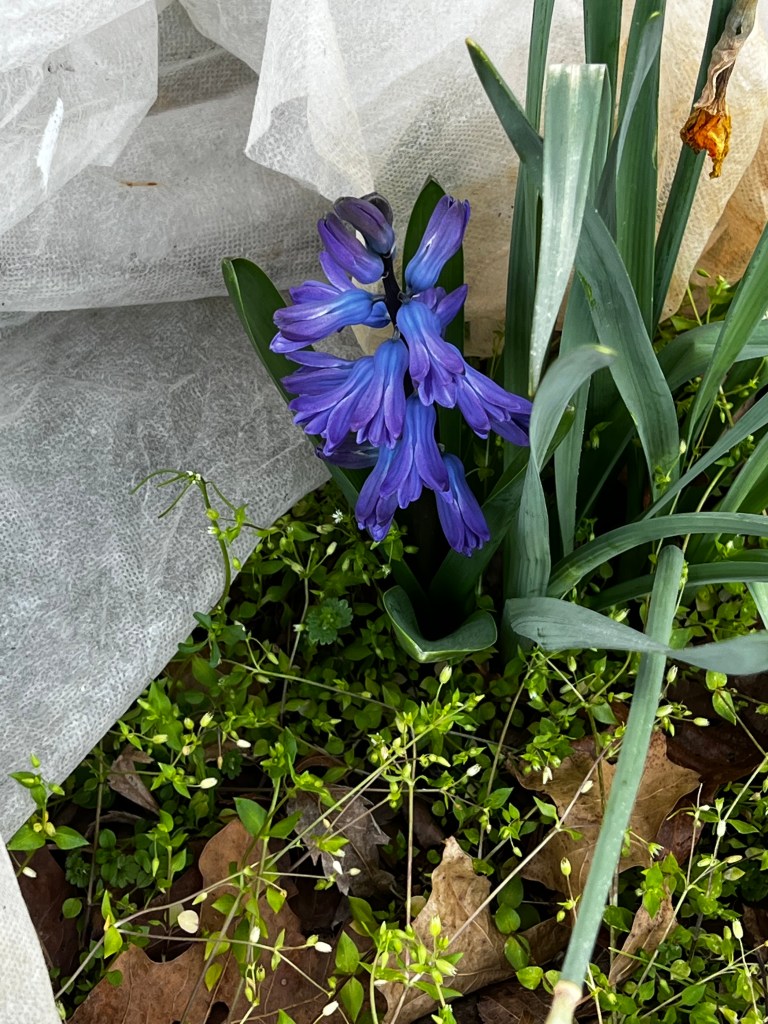March 11, 2022

Years ago, Melissa and her mom planted a variety of bulbs in the front beds of our house. The daffodils (Narcissus spp.) have bloomed every year, and this year we already have two different varieties in the maple bed and mailbox bed. Grape Hyacinth (Muscari armeniacum) bulbs were planted at the same time, and they have literally exploded. They take over the mailbox bed every spring and have spread seed throughout our yard. These shoots come to flower prior to my first mow of the season. The hyacinth never bloomed during Melissa’s time here, nor since our return three years ago. This year the hyacinth finally bloomed, after lying dormant for over a decade.
When I looked online, I found the common hyacinth (Hyacinthus orientalis), also called the garden hyacinth or Dutch hyacinth, is a species of flowering plant in the family Asparagaceae (yes, like asparagus), native to southwestern Asia, southern and central Turkey, northwestern Syria, Lebanon, and northern Israel. It was introduced to Europe in the 16th century and is now widely cultivated throughout the temperate world for its strong fragrant flowers which appear quite early in the season. It appears our bulb is the ‘Royal Navy’ variety. This is a hardy, perennial which bears up to 40 dark-blue double flowers, ¾-1½ inches (2-3.5cm) long, packed into a head 8 inches (20cm) tall. Hyacinth bulbs need to be planted in fall to allow the bulb to experience the cold winter temperatures, allowing it to break dormancy in the early spring.
All flowering plants do so at a particular time according to their species. It is possible to make a plant flower at other times by artificially creating the proper conditions. This process is known as “forcing” and is often used by commercial growers. Hyacinth is among the most popular bulbs for forcing and this is commonly done around the Christmas season. The bulbs can be forced indoors by depriving light and warmth for several weeks, then placing them in a bright, cool place such as a kitchen windowsill. Hyacinth bulbs can also be forced in a narrow-necked vase of water, which allows you to view the root growth. Other cultivars of bulbs suited to forcing are crocuses and daffodils. It was advised to always wear gloves when handling the bulbs as they contain oxalic acid, which can cause skin irritation.
THOUGHTS: When the hyacinth came up in our bed, Melissa thought it might be a crocus. She made this suggestion without looking at the flower, but the hyacinth had never bloomed, and I knew this was not the daffodil blooming beside it. I later realized this was a not a crocus due to the rows of double flowers. Melissa’s sister suggested the hyacinth may have bloomed because of the garden netting we placed over the bed to protect it from the cold. The hyacinth bulb received the cold needed for dormancy, and the mesh allowed the soil to warm quickly. In essence, we had forced the bulb outside rather than on our windowsill. Humans can create artificial conditions to force flowers to react at unnatural times. We do the same thing with animals when we tame, then domesticate species. This has not worked when we have tried to “force” other humans. To live together we must treat everyone with respect and acknowledge their worth. Do the work. Change is coming and it starts with you.